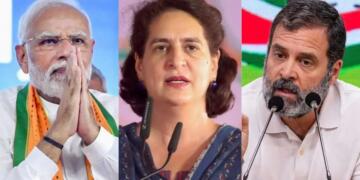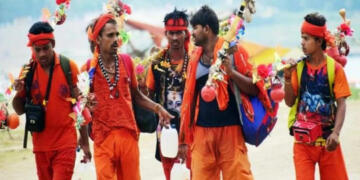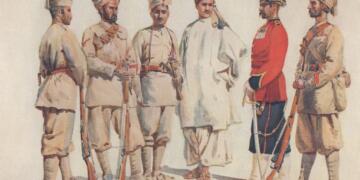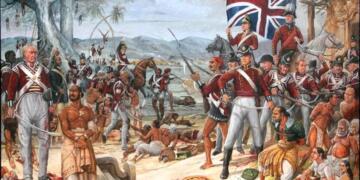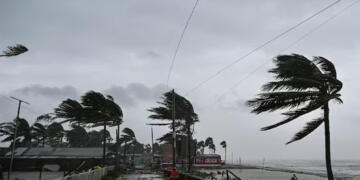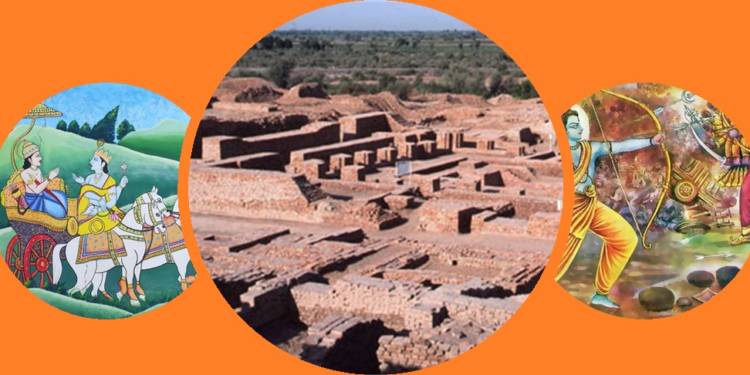The answers to the question of how the world came to be settled, has been a topic of extreme interest to mankind. In fact, this has not been a topic only limited to academia, but key element of popular culture too. The issues of ancestry, of immigrating or emigrating to different geographies, original homelands etc. are matters that are discussed and kept alive at individual and family level and are perhaps the most common conversational subject just after weather. It is safe to say, that humans are hardwired to remember and carry forth race memories at a biological level. Surely, the shared lores of the past would have helped the ancient man survive in the ancient world. The knowledge of threat and resources linked different eco-systems being part of material successes of a tribe. It is no surprise therefore, that such narratives form the core texts of all civilizations and cultures, from tribal hunter gatherers to the citizens of settled empires.
In time, this topic also has been addressed at a scholarly level. In the western context, this was preserve of philosophers and religious authorities, where as traditional Indian schools had genealogy and history debated both as itihaas as well as sciences in a polymath approach. In most recent times, as the western forms dominated the world, these topics were predominated by the schools of liberal arts, a continuation of its previous approaches of looking at the subject through lens of organized priesthood. The impact of sciences, from biologists and evolutionists mapping the species to geologists examining water channels was to wait till a much later day. Of the traditional approaches, archeology had been perhaps the first to embrace the new schools of science, while historians and linguists of the western mold have yet been still tentative in embracing the knowledges of maths and statistics etc which could have revolutionized the understanding of the past. It is only now that first tentative stabs at taking a synthesized approach through various disciplines is being taken up and while many explanations continue to elude us, we have first set of meaningful observations coming in.
It is in this background, that genetics is making a significant impact on the story of peopling the world. Closer home, how the Indian continent, the home to largest and most diversified human populations throughout history, was peopled, is a puzzle where the impact of genetics is keenly followed. While there have been tentative publications in the past, the analysis of some recently discovered ancient skeletal material has shed new light on hitherto opaque chapters. Of these, the most exciting news has come in the form of a paper in the cell magazine (ref 1) where the genetic material from a skeleton from Rakhigarhi was used along with pre 2000 BCE remains from areas in close connect with IVC/SSC to profile the populations present then. This was accompanied by another paper in the science magazine sharing many of the same authors, who examined the genetic evidence of ancient people in Indian subcontinent and Central Asia (ref 4). These papers, while largely focusing on the genetics, also have some archeological aspects and historical theorizing built it.
While the papers were largely in agreement, especially with respect to the pre-2000 BCE period, where things get interesting, is “tail end” part of what happened post 2000 BCE, with one paper making explicit statements, not necessarily supported by the other paper. Further the other “interesting” parts also pertain to mapping the genetic understanding on the overall historical map. The part of the papers, dealing with genetics themselves is something we can take as proven, due to the fact that the methods and data set are proven and have gone through peer review and are in domain of solid sciences. However that does not impose on us any limitation to question and or further develop their interpretations. We can therefore separate the solid observations on genetics listed in the paper with the generic material, and then take the data forward and build into it additional knowledge from a multidisciplinary approach. Further, these are not the only papers on genetics, and we can include additional learnings as we go forward.
Let us first examine some of the more solid evidences that are presented in genetic studies
SSC in the 2500 BCE era has presence of population which is related to Iranian population, but had broken away from the same at least 12,000 years BPE. Thus there is no large scale migration from Iranian plateau into India, else the Iranian related population within India would carry the markers seen in the ancient Iranians. This population set also does not carry markers seen in the CAR population. This population however does carry markers also seen in some of the earliest population seen in the southern part of Indian subcontinent. This population then goes on to provide the largest base substratum for the modern population of the entire Indian subcontinent. (ref 3)
Around 1500s time frame, we see some populations in the NW extreme of Indian subcontinent with primarily SSC genetic base but with shared markers with CAR populations, these markers are primarily based on presence of R1a haplogroup. This attests to admixture of SSC populations with other populations set.
It is post these two definite factoids, that the two papers diverge drastically. The science paper, moves on to making the case that modern Indian higher castes (viz Brahmins) are of CAR stock. However there is moves to very shoddy science, as it carries out multiple misinterpretations of its own genetic data using the social sciences prism to justify pre-decided conclusions rather than explorations. These are
It only compares some samples of specific caste groups to CAR genetics, and does not carry out a comprehensive study of R1a and Y haplogroup studies done across larger Indian population.
It ignores existing genetic research where a wide study of Indian populations was done, with significantly different results obtained.
Its own genetic research finds, that the “relatedness” with CAR population for groups living far inside India, as measured by presence of R1a haplogroup within Y chromosome, is more through males than that found in the older admixture at the boundaries of the sub-continent which is more in females, and yet indulges in marvelous sophistry to explain it as “However, sex bias varied in different parts of South Asia, as in present-day South Asians” and therefore the proportion changed.
We are therefore, constrained to call out the last bit of myth making on the structure of modern Indian populations as poor science, and is possibly the result of a set of scientists who had been long vested into established model for long not being able to disassociate themselves from the same despite newer data. What is very interesting to note too is that the first paper is completely silent on the issue, and in fact an interview with Dr Neeraj Rai (ref 2), one of the co-authors of both the papers, takes a stance which at times directly goes against paper 3. He calls out that not only there is a likely out of India gene flow from SSC area, but there is available but yet unpublished data, on R1a haplogroup and other such material where a out of India gene flow seems far more reasonable for R1a genetic stream too. He also calls out that the relationship to CAR population existed with all Indian populations today, and was not a caste specific matter.
Interestingly, in terms of examining the issue of modern Indian populations, we find that material is present already from genetic studies, and while we look forward to material from Dr Rai, we have other recent studies to refer already. References 5 and 6, examine the presence of R1a within Indian populations. One of these papers is from 2009, and has not been yet countered. The other paper is from 2017, and talks of R1a in tribal sub-groups. Both the papers, along with the interview from Dr Rai bring out the following points.
Indian population as whole, as seen from depth and width of genetic mutations is the oldest seen the world.
The scale and scope of genetic mutations in India is high across all genetic families *including* the R1a* subgroup with is often associated with the CAR population. This indicates that the R1a originated in the Indian subcontinent.
While different populations and caste groups do have some variation in the genetic material, the Indian populations are all well mixed both geo-graphically and caste wise. There are ancient tribal populations embedded deep within India carrying a very high proportion of R1a gene.
The reference 5 in particular goes onto say that the Indian populations are closer to each other than they are to west. The other very striking observation made in the paper is captured in the spatial distribution maps of Y-haplogroup R1a1, which essentially gives us a center for R1a*, they are seen in two images as follows:
(a) Spatial frequency distribution of Y-haplogroup R1a1* across Eurasia, Central Asia and the Indian subcontinent.
(b) Spatial distribution of Y-haplogroup R1a1*-associated diversity based on microsatellite markers.
The extant genetic data has now already provided significant information on Indian populations, and while there is more to come yet, there exists enough information for us to start marrying the archeo-genetics with literary and oral evidences to create a composite historical picture. To that end, let us remind ourselves of a few of the relevant points.
The area of the earliest part of Avesta, the first Iranian text, geographical area of Avesta was dominated by the Hindu Kush range at the center, the western boundary being marked by the districts of Margiana, Areia, and Drangiana, the eastern one by the Indo-Iranian frontier regions such as Gandhāra, Bunēr, the land of the “Seven Rivers.” (ref 8)
The earliest Avesta refers to a homeland which is consanguineous with Hindu/Jain/Buddhist cosmology, clearly memories of a shared homeland including geographical references to Jambudivpa (but one the western “scholars” are unable to understand where)
Avesta shares both the flood myth (of Manu) and earliest Vedic gods with the Vedic pantheon, but does not carry over later developments in Vedic corpus
The Das-Rajanya war, the battle of ten kings is a epic of early Vedic civilization, which talks of a rift in the Vedic tribes following which some tribes went “west” while Sudas continued in Ravi region. (ref 7) This is infact one of the earliest episodes of Vedic history.
As opposed to the Lunar dynasty of Purus the solar dynasty of Ikshvakus is the east, and they are cousins to Purus through Manu and his son Ila
The kingdoms of Puru’s in the five rivers area, and the kingdoms of the east, are largely independent till the time of Mahapadmanand, when Magadh conquered the Kuru areas and combined the same in a single administrative unit (Prior chakravartin samrats are not known to have gone more than establishing feudatories)
The literary evidences, taken together with the archeo-genetics puts together a jigsaw puzzle in a very compelling manner:
The proto-Iranian population split from the SSC population around late glacial during or before 13000 BPE. The flood myths along with swaraswati river common to both as well as memories of returning cold in younger dryas (ref 9) at 12,900 to c. 11,700 years BP coincide with the age of genetic split between SSC and Iranian populations. This age also corresponds to the first few generations after peopling of the world (Indian subcontinent) through Vaivasvata Manu where the dasrajanya yuddha would have taken place. The age of genetic split determines the date of cultural split in this case with clear divergence of material cultures and literary evidences post the split and shared commonality before.
The peopling of Indian subcontinent was through three ancient pools, one centered in the south of India, one in the SSC region, and one in the east Gangetic belt from Nepal to India border. The SSC civilizations and Gangetic civilizations were Vedic cousins. While the SSC region held prominence in terms of Rig Vedic formation, the Gangetic tribes (attested to through Iskhvaku lineage) – contributed to R1a haplogroup parent family. Possibly this R1a set was Himalayan tribal population which might have spread into CAR during the last ice age. As sons of Manu, they were known to be extension of the Vedic family, however their prominence in the Vedic society had to wait till towards end of SSC period, with the time frame till then dominated by their SSC cousins (despite Ramayana)
Post SSC, the Gangetic valley population takes a major role in the Indian subcontinent. Empires centered in eastern Gangetic plains take over India, with corresponding mixing of populations.
At all times, there continues a bidirectional population exchange (stories of Manu being a Dravida king) with south India, with ancient south Indian populations mixing with SSC population to create ASI population. This population then further combines with ANI (formed through combination of SSC population and Gangetic valley population) to create the modern Indian population.
While at no point of time in the above discussion have we used the dating of Ramayana, Mahabharata and Shakya Muni Gautama Buddha through astro-archeology and other such methods, it is notable that dates of Ramayana and Mahabharata as attested, dovetail neatly into the above timelines and are not at odds with it. (Going into the detailed timelines would be another exercise, however interestingly a timeline made purely from textual references made prior to genetic evidence being made available is in ref 10)
In dealing with epochal timescales, the above study is positively rushed, and essentially summarizes and links together the main events in a big picture approach. This means that the details may be missing and some of the timescales can have some movement as we nail down each of the happenings. However, none of that is likely to now disturb the big picture and broad contours of the population map. We look forward to additional research from archeo paleontology, genetics and other sciences to shed greater light on the time lines, so we may update and correct our understanding in time.
References
1.) An Ancient Harappan Genome Lacks Ancestry from Steppe Pastoralists or Iranian Farmers
2.) https://www.cell.com/cell/pdf/S0092-8674(19)30967-5.pdf
3.) The Ancient Harappan Genome and its impact on the Aryan Migration Theory
4.) https://www.youtube.com/watch?v=U__2851gcR4&fbclid=IwAR2rkDUXc6X1wyrTErSf6seJ-hS6RBFMyBK1rSwU-wIZDA5AvkvwW5wSPYg&app=desktop
5.) Indus Valley Civilisation is largest source of ancestry for South Asians: David Reich
6.) https://economictimes.indiatimes.com/news/politics-and-nation/indus-valley-civilisation-is-largest-source-of-ancestry-for-south-asians/articleshow/71042072.cms
7.) The formation of human populations in South and Central Asia https://science.sciencemag.org/content/365/6457/eaat7487
8.) The Indian origin of paternal haplogroup R1a1* substantiates the autochthonous origin of Brahmins and the caste system
9.) https://www.nature.com/articles/jhg20082
10.) Y Chromosome Haplogroup Distribution in Indo-European Speaking Tribes of Gujarat, Western India
11.) https://journals.plos.org/plosone/article?id=10.1371/journal.pone.0090414
12.) The Recorded History of the Indo-European Migrations
13.) http://talageri.blogspot.com/2016/07/the-recorded-history-of-indo-european.html8
14.) AVESTAN GEOGRAPHY
15.) http://www.iranicaonline.org/articles/avestan-geography
16.) Late glacial and Dryas
17.) https://en.wikipedia.org/wiki/Younger_Dryas
18.) https://en.wikipedia.org/wiki/Late_Glacial
19.) Family Tree of the Kurus
20.) https://ramanan50.wordpress.com/2014/05/29/manu-to-janamejaya-mahabharat-kuru-dynasty/




